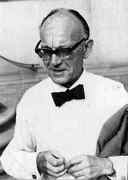Person: Deuring, Max F.

Max Deuring was a German mathematician who worked in in arithmetic geometry and analytic number theory.
Mathematical Profile (Excerpt):
- Max was brought up in Göttingen completing his school education at the Oberrealschule there.
- Deuring was captivated by the new approach to algebra which Emmy Noether was developing at Göttingen and, from 1927 on, she advised him on the research for his doctorate.
- He submitted his doctoral dissertation Arithmetische Theorie der algebraischen Funktionen Ⓣ(Arithmetic theory of algebraic functions) in 1930, the degree being conferred in the following year.One of the great strengths shown by Deuring at this stage, and throughout his career, was an ability to make simplifications and generalisations to existing work.
- He was four years older than Deuring but the two had become friends, both being part of the circle of young mathematicians around Emmy Noether.
- After short spells at the University of Rostock and the University of Groningen, van der Waerden had been appointed professor of mathematics at the University of Leipzig in 1931 and Deuring was appointed as his assistant.
- By 1935, with an excellent publication record behind him, including his famous book Algebren Ⓣ(Algebras) published in that year, Deuring wanted to qualify as a lecturer and submit his habilitation thesis.
- Helmut Hasse was by this time director of the Mathematical Institute at Göttingen and he encouraged Deuring to habilitate there.
- Tornier was supported by militant Nazi sympathisers among the students, and Deuring was refused the right to lecture by the Ministry.
- Perhaps Deuring's greatest mathematical idea came in 1936.
- However before that we will follow the rest of Deuring's career.
- This was not the most attractive of appointments for Deuring since the University of Posen had been set up by the Nazis in Poznán, Poland.
- Deuring remained in Poznán until the end of the war when he returned to his home town of Göttingen.
- The chair remained unfilled until 1950 when Deuring was appointed.
- Deuring's 'greatest mathematical idea' which we referred to above was an idea on how to generalise Hasse's result but to do this he had to introduce a radically new approach.
- Deuring was in Leipzig in 1936, having failed to be accepted at Göttingen in the previous year as we explained above.
- What Deuring had found was a way to approach extending Hasse's results from curves of genus 1, the elliptic curves, to curves of higher genus.
- It was neither Hasse nor Deuring who finally proved the result which both were trying to obtain.
- However Deuring presented his new ideas on the algebraic theory of correspondences in two papers, both of which were published by Crelle's journal.
- The generalisation of the Riemann hypothesis to function fields of arbitrary genus was first achieved by André Weil in 1948, but he did so using Deuring's theory of correspondences.
- Deuring continued to produce important papers.
- In his paper 'Reduktion algebraischer Funktionenkörper nach Primdivisoren des Konstantenkörpers' Ⓣ(Algebraically reduced function fields after prime divisors of the field of constants) Deuring developed a coherent general theory of good reduction which covered all special cases which were encountered so far.
- Although this paper appeared one year later than the 1941 paper on endomorphism rings, it was completed earlier, and Deuring used it in an essential way in his study on endomorphism rings.
- During his years at Göttingen, Deuring made many trips abroad but had two longer visits, one to the Institute for Advanced Study at Princeton, the other at the Tata Institute of Fundamental Research in Bombay, India, in 1958.
Born 9 December 1907, Göttingen, Germany. Died 20 December 1984, Göttingen, Germany.
View full biography at MacTutor
Tags relevant for this person:
Origin Germany
Thank you to the contributors under CC BY-SA 4.0! 

- Github:
-

- non-Github:
- @J-J-O'Connor
- @E-F-Robertson
References
Adapted from other CC BY-SA 4.0 Sources:
- O’Connor, John J; Robertson, Edmund F: MacTutor History of Mathematics Archive
